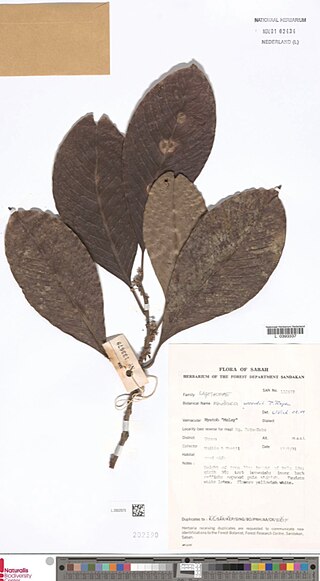
Madhuca daemonica is a tree in the family Sapotaceae.
Madhuca dubardii is a plant in the family Sapotaceae.
Madhuca endertii is a plant in the family Sapotaceae.
Madhuca erythrophylla is a plant in the family Sapotaceae. The specific epithet erythrophylla means "red leaves".
Madhuca kingiana is a tree in the family Sapotaceae. It is named for the botanist George King.
Madhuca korthalsii is a tree in the family Sapotaceae. It is named for the Dutch botanist P. W. Korthals.
Madhuca kuchingensis is a tree in the family Sapotaceae. It is named for the city of Kuching in Borneo.
Madhuca lancifolia is a tree in the family Sapotaceae. The specific epithet lancifolia means "lance-shaped leaves".
Madhuca malaccensis is a tree in the family Sapotaceae. It is named after Malacca in Peninsular Malaysia.
Madhuca ochracea is a tree in the family Sapotaceae. The specific epithet ochracea means "yellowish brown", referring to the indumentum.
Madhuca palembanica is a tree in the family Sapotaceae. It is named for Palembang in Sumatra.
Madhuca pallida is a tree in the family Sapotaceae. The specific epithet pallida means "pale in colour", referring to the leaves.
Madhuca primoplagensis is a tree in the family Sapotaceae. The specific epithet primoplagensis means "first region", referring to Sarawak's First or Kuching Division, the tree's native habitat.
Madhuca pubicalyx is a tree in the family Sapotaceae. The specific epithet pubicalyx means "soft-haired calyx".
Madhuca sepilokensis is a tree in the family Sapotaceae. It is named for Sepilok in Malaysia's Sabah state.
Madhuca sericea is a tree in the family Sapotaceae. The specific epithet sericea means "silky", referring to the indumentum.
Madhuca silamensis is a tree in the family Sapotaceae. It is named for Mount Silam in Borneo.
Madhuca utilis is a tree in the family Sapotaceae. The specific epithet utilis means "useful", referring to the timber.
Madhuca vulpina is a tree in the family Sapotaceae. The specific epithet vulpina means "fox-like", referring to the colour of the indumentum.

Madhuca woodii is a tree in the family Sapotaceae. It is named for the botanist Geoffrey Wood.


